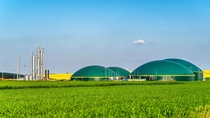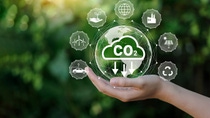Monomers
Product Carbon Footprint
How much greenhouse gas (GHG) emissions are associated with a product along its life cycle?
This question becomes increasingly important with more and more companies setting goals to reduce GHG emissions and the Product Carbon Footprint (PCF) is the answer to it. The PCF sums up the total GHG emissions generated by a product over the different stages of its life cycle.
A cradle-to-gate PCF considers all the processes from resource extraction through manufacturing of the final product up to the point where it leaves the company gate. A cradle-to-grave PCF covers the complete life cycle of the product, including the emissions from the use phase and end-of-life of the product.
We have developed a digital application to calculate the cradle-to-gate PCFs for all our 45,000 sales products. You as a customer can receive valuable information about the extent to which our materials contribute to your corporate or product carbon footprint.
Our PCF calculation is based on GHG emissions from our own plants and high-quality average data for purchased raw materials and energy. We will gradually replace average data with supplier specific data for purchased raw materials as soon as they become available from our suppliers.

Being a pioneer in PCF calculation and methodology, we have engaged with other chemical companies to jointly define a PCF methodology and establish a level playing field. In the Together for Sustainability (TfS) initiative, 47 companies from the chemical industry, including BASF, agreed on a uniform global standard for calculating their PCFs at the end of 2022.
In September 2023, the German technical inspection agency TÜV Rheinland certified that our method to calculate and report the PCFs fully complies with the requirements specified by TfS. We are the first company to align its fully automated PCF calculation system with the TfS rules.
Options to reduce your PCF
At BASF, we have set ourselves ambitious goals and are striving worldwide to achieve net zero CO2 emissions by 2050 and to reduce GHG emissions by 25 percent by 2030 compared with 2018. We aim to achieve this despite targeted growth and the construction of a large Verbund site in South China.
What gives us confidence, that we can achieve this? Our track record: since 1990, we have been able to lower our overall greenhouse gas emissions from BASF operations by ca. 54% and even reduce specific emissions (per metric ton of sales product) by ca. 75%. This was achieved by a range of activities and initiative like the following:

Continuous process optimization
For instance, we have installed our own nitrous oxide (N2O) decomposition catalysts in all plants where N2O is created as a by-product. This is especially relevant in the production of adipic acid where a significant amount of N2O, a greenhouse gas with the power of 265 times of CO2, is created and released to the environment if no abatement is done.

For example, waste heat from one plant’s production process is used as energy in other plants. The Verbund saved us around 19.0 million MWh in 2022, which translates to 3.8 million metric tons less CO2 released into the environment.

For instance, BASF bought 49.5% of the Vattenfall wind farm Hollandse Kust Zuid in September 2021. With an installed capacity of 1.5 gigawatt “Hollandse Kust Zuid” will at that point be one of the biggest offshore wind farms across the globe.
Why is this important?
Emissions from raw materials, so-called scope 3 emissions, make up a significant portion of a product’s carbon footprint. For many businesses, scope 3 emissions account for more than 70 percent of their carbon footprint. By establishing the PCF as purchase criterion and re-evaluating your supplier choice, you can save CO2 emissions immediately.
Not enough?
Let’s go further! By using recycled or renewable raw materials instead of fossil resources, we can save even more CO2 emissions. Our portfolio comprises the following products with reduced carbon footprint:

Feel free to contact us!
Let’s discuss how we can support you in developing high-quality and sustainable solutions for your business.



